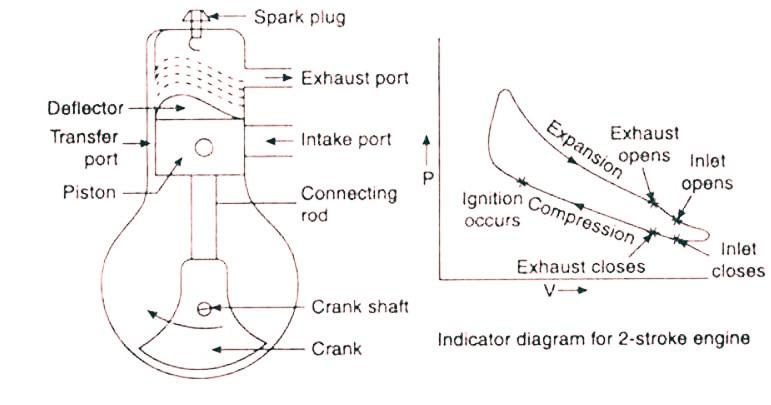
Draw a neat diagram of the petrol engine and label the following parts :
a) Piston b) Spark plug c) Crank shaft
Answer
554.1k+ views
Hint: A petrol engine is an internal combustion engine with a spark plug that ignites the fuel and makes the engine start, it is designed to run on petrol. Petrol engines are four-stroke engines comprising the steps of intake, compression, power, and exhaust.
Complete answer:

Here in the above diagram is an internal cross-sectional view of a petrol engine, and an inductor diagram for 2 stroke engine.
A petrol engine is an internal combustion engine with a spark plug which ignites the fuel and makes the engine start, it is designed to run on petrol.
This engine converts heat energy coming from ignition of petrol to work energy by turning the wheels of a car or bicycle.
This type of engine is made up of a fixed cylinder and a piston that is movable. The piston is pushed by the expanding pressure due to the combustion of petrol, which in turn rotates the crankshaft and ultimately, through a system of gears, this motion in the crankshaft drives the vehicle’s wheels.
An example of the internal Combustion engine is a spark ignition-petrol engine, combustion is also known as burning, it is the basic chemical process of extracting energy from a fuel and air mixture. The ignition and combustion of the fuel occur within the engine itself in an internal combustion engine (ICE).
Note:
In a spark-ignition engine or a petrol engine, the fuel is mixed with air and then released into the cylinder during the process of intake. The spark ignites it after the piston compresses the fuel-air mixture, which causes combustion releasing a part of energy in the form of work done.
Complete answer:

Here in the above diagram is an internal cross-sectional view of a petrol engine, and an inductor diagram for 2 stroke engine.
A petrol engine is an internal combustion engine with a spark plug which ignites the fuel and makes the engine start, it is designed to run on petrol.
This engine converts heat energy coming from ignition of petrol to work energy by turning the wheels of a car or bicycle.
This type of engine is made up of a fixed cylinder and a piston that is movable. The piston is pushed by the expanding pressure due to the combustion of petrol, which in turn rotates the crankshaft and ultimately, through a system of gears, this motion in the crankshaft drives the vehicle’s wheels.
An example of the internal Combustion engine is a spark ignition-petrol engine, combustion is also known as burning, it is the basic chemical process of extracting energy from a fuel and air mixture. The ignition and combustion of the fuel occur within the engine itself in an internal combustion engine (ICE).
Note:
In a spark-ignition engine or a petrol engine, the fuel is mixed with air and then released into the cylinder during the process of intake. The spark ignites it after the piston compresses the fuel-air mixture, which causes combustion releasing a part of energy in the form of work done.
Recently Updated Pages
Master Class 12 English: Engaging Questions & Answers for Success

Master Class 12 Business Studies: Engaging Questions & Answers for Success

Master Class 12 Economics: Engaging Questions & Answers for Success

Master Class 12 Social Science: Engaging Questions & Answers for Success

Master Class 12 Maths: Engaging Questions & Answers for Success

Master Class 12 Chemistry: Engaging Questions & Answers for Success

Trending doubts
What are the major means of transport Explain each class 12 social science CBSE

Differentiate between homogeneous and heterogeneous class 12 chemistry CBSE

Draw a ray diagram of compound microscope when the class 12 physics CBSE

How is democracy better than other forms of government class 12 social science CBSE

What is virtual and erect image ?

Explain the energy losses in the transformer How are class 12 physics CBSE




